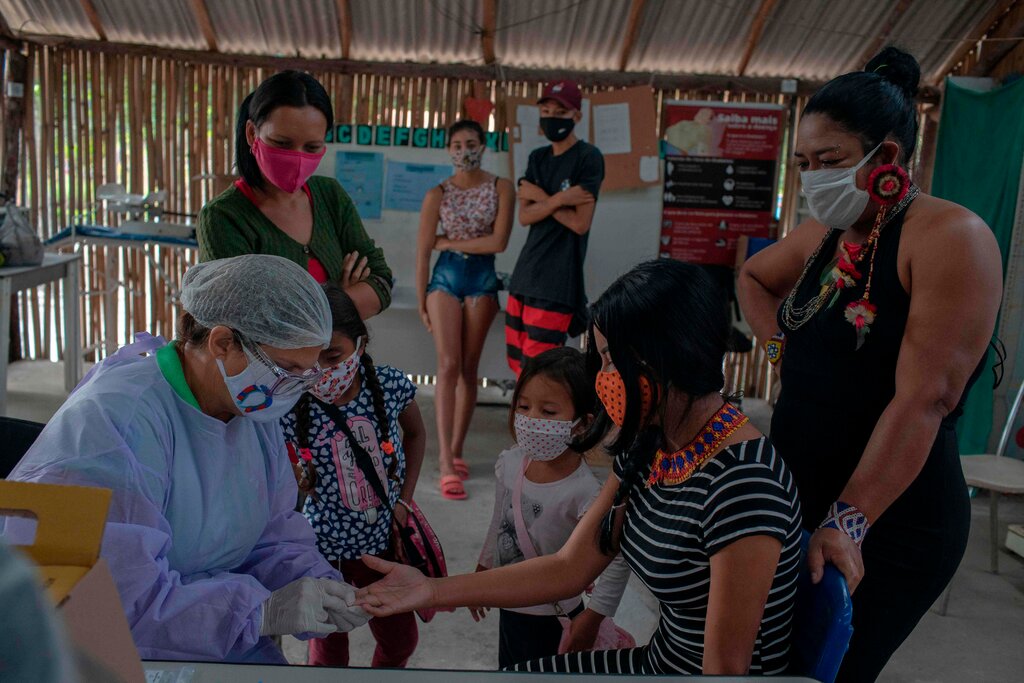A New York Times investigation has revealed that Brazilian health workers assigned to care for indigenous communities may have inadvertently exposed and infected their members, already some of the most vulnerable populations, with the coronavirus. The rapid growth of coronavirus cases and deaths within indigenous communities has contributed to mounting criticism of President Jair Bolsonaro’s handling of the pandemic.
From the onset of the pandemic, some indigenous communities, like the Kanamari, sought to limit outside access to their territories to avoid contagion. But in late May, about a week after medical workers’ visit to Kanamari territory, elderly members began to show symptoms of the virus. Interviews and federal data obtained by the Times seem to confirm the correlation: over 1,000 health workers with the federal Indigenous Health Service (Sesai) have tested positive for the virus as of early July. Many had come into contact with indigenous communities without adequate protective equipment.
Sesai states that reports that health workers have exposed indigenous communities to the virus are “inconclusive,” but at least six field offices have had shares of infected workers surpassing the Amazon region’s average of eight percent. The office overseeing the state of Amapá and the northern part of the state of Pará, for example, has reported that almost half of its health workers had tested positive. In the office overseeing the Yanomami community, over 20 percent of the staff has been infected.
And health care workers’ union representatives and experts say the true number of infections among Sesai health workers is likely much higher. As of June 30, only 1,080 employees had been tested, amounting to about five percent of its workers. More than 15,000 indigenous Brazilians have been diagnosed with the virus, and at least 523 have died. At least 10,889 of the diagnosed live in protected territories, according to Instituto Socioambiental, an Indigenous rights organization.
“There were failures in the protection of health care workers at a critical moment, affecting teams that care for a highly vulnerable population,” said Felipe Tavares, a researcher at the Federal Fluminense University. A short supply of tests has meant that asymptomatic or undiagnosed health workers have come into contact with patients, potentially transferring the virus to them. Some teams have not been given appropriate equipment and have had to procure their own masks and gear.

This response reflects the broader shortcomings that have turned Brazil into the second country with the highest number of deaths globally, with over 78,772 deaths and more than two million confirmed cases.
Doctor and anthropologist Luiza Garnelo highlights how the pandemic has exposed the defenselessness of communities that had already been grappling with substandard access healthcare and poverty. “Long before the epidemic hit, investment in Indigenous health care was insufficient and the resources that are available were not harnessed in a way that enabled an effective response to the epidemic,” she said. “The Indigenous population is socially and economically vulnerable.”
Júnior Yanomami, who heads the Indigenous council at the Yanomami health department in Boa Vista, explained how communities have pleaded with the federal government for support and resources to face the pandemic. Tribal leaders said that when the Army colonel at the head of Sesai, Robson Santos da Silva, visited Yanomami villages to deliver equipment and administer tests, they felt they were being used for photo ops. Additionally, at least 90 of the 131 health workers assigned to the region have tested positive for the virus. 262 Yanomami members have been diagnosed, and five have died from the virus.
President Bolsonaro, who has had a historically antagonistic relationship with indigenous communities, faces intensified criticism. Last month, he vetoed several points of a law approved by the country’s Congress and Senate aimed at protecting indigenous communities against the coronavirus. The vetoed points would have assured access to drinking water, free distribution of hygiene products and cleaning and disinfection materials. He additionally vetoed a proposal for emergency funds for indigenous healthcare and the emergency provision of more hospital beds and intensive care units for these communities.
The vetoes came on the same day that a Supreme Court judge ordered the government to take measures and increase efforts to protect indigenous peoples from the virus. Since, another Supreme Court judge has warned that the armed forces could be held responsible for a “genocide” over their handling of the pandemic in indigenous communities.
Meanwhile, the damage to indigenous communities is irreversible. Edney Kokama, a leader of the Kokama tribe, explained how he lost his father and grandfather, along with at least 58 members of the tribe, to the virus. His grandfather and his wife, who has also died, were of the few fluent members of the tribe’s language. “My grandfather was editing a Kokama dictionary. He was one of the few who still spoke it,” he said. “We’ve lost so much knowledge.”
Photo: Tarso Sarraf/Agence France-Presse
